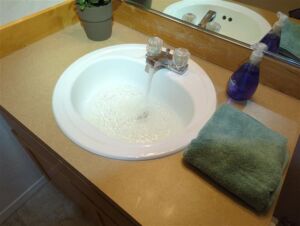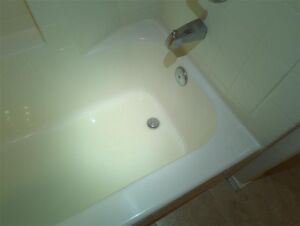
Clogs in the pipes below the fixture are the most common cause of slow draining. Things are debris, hair, soap scum, and others will often accumulate in the trap below the fixture and prevent the fixture from draining properly. Kitchen sinks are affected by grease buildup when people pour grease down the sink. Pouring boiling water can be effective in breaking down grease and other clogs at the kitchen sink. It can help with bathroom sink clogs but is often not as effective.
In the bathrooms, hair is the most common item to clog the pipes. The hair can be physically removed by removing and cleaning the P-trap under the sink. The P-trap is the section of pipe that looks like the letter “U.” We recommend putting a bucket underneath the trap before removing it to catch the water that will drain out.
The most common tool to address toilet clogs is the plunger. However, the plunger can be used with other fixtures as well. Just be aware of potential contamination. To avoid contamination, do not use a plunger that was used in a toilet to unclog other fixtures in the home. A plunger is a great tool that is both inexpensive and easy to use. It can often clear a minor clog without too much difficulty. To use it, place the plunger over the drain to create a seal, and then push and pull rapidly to create suction. The suction helps dislodge and break up the clog. This will often restore proper drainage.

If unable to clear the clog with the above methods, an auger of snake can be caused, These are plumbing tools that can reach deeper into the pipes and physically break up the clogs. They can be purchased or rented at most home improvement stores however, most homeowners will hire a plumber to snake their clogged lines.
If the above methods do not work to restore proper drainage at the fixture, a more serious plumbing issue may exist. Things like improper fixture venting, incorrect pipe slope, sewer line obstructions, and poor drain pipe design can all cause slow drainage. A plumbing contractor will need to identify the cause of the issue and the required repair.
As you can see, the issue of a slow-draining fixture can often be resolved by a homeowner with very little effort or monetary investment. However, this condition can also signal that a more serious issue exists. It is best to attempt to address the problem as soon as it is observed. Waiting until the fixture stops draining entirely is a mistake. The fixture can overflow and cause damage. It can also keep you from using that fixture while you wait for a plumber to come out and fix it. As with all home-maintenance items, it is always best to be proactive.
You can learn how to unclog a drain here:
